Journal of Computational Physics 295 (2015) 161–188
Contents lists available at ScienceDirect
Journal of Computational Physics
www.elsevier.com/locate/jcp
Generalized Multiscale Finite-Element Method (GMsFEM) for
elastic wave propagation in heterogeneous, anisotropic media
Kai Gao a,∗,1, Shubin Fu b, Richard L. Gibson Jr. a, Eric T. Chung d,
Yalchin Efendiev b,c
a Department of Geology and Geophysics, Texas A&M University, College Station, TX 77843, USA
b Department of Mathematics, Texas A&M University, College Station, TX 77843, USA
c Numerical Porous Media SRI Center (NumPor), King Abdullah University of Science and Technology, Thuwal, Saudi Arabia
d Department of Mathematics, The Chinese University of Hong Kong, Shatin, NT, Hong Kong
a r t i c l e
i n f o
a b s t r a c t
Article history:
Received 31 August 2014
Received in revised form 29 March 2015
Accepted 31 March 2015
Available online 14 April 2015
Keywords:
Elastic wave propagation
Generalized Multiscale Finite-Element
Method (GMsFEM)
Heterogeneous media
Anisotropic media
It is important to develop fast yet accurate numerical methods for seismic wave propagation
to characterize complex geological structures and oil and gas reservoirs. However, the
computational cost of conventional numerical modeling methods, such as finite-difference
method and finite-element method, becomes prohibitively expensive when applied to very
large models. We propose a Generalized Multiscale Finite-Element Method (GMsFEM)
for elastic wave propagation in heterogeneous, anisotropic media, where we construct
basis functions from multiple local problems for both the boundaries and interior of
a coarse node support or coarse element. The application of multiscale basis functions
can capture the fine scale medium property variations, and allows us to greatly reduce
the degrees of freedom that are required to implement the modeling compared with
conventional finite-element method for wave equation, while restricting the error to low
values. We formulate the continuous Galerkin and discontinuous Galerkin formulation of
the multiscale method, both of which have pros and cons. Applications of the multiscale
method to three heterogeneous models show that our multiscale method can effectively
model the elastic wave propagation in anisotropic media with a significant reduction in
the degrees of freedom in the modeling system.
Published by Elsevier Inc.
1. Introduction
Seismic wave propagation has long been a fundamental research field in both global scale seismology and reservoir ex-
ploration scale seismics. There are two basic categories of methods to investigate the propagation of waves through the Earth
media, approximate methods and the full wavefield (exact) methods. Approximate methods rely on either the simplification
of the Earth media, or the approximation of the wave equation, which include, for instance, the ray tracing method [14,9,47],
the Gaussian beam method [55,50], the one-way wave equation approach [22,104], the reflectivity method [62], etc. These
methods are generally fast and computationally affordable. However, they are intrinsically incomplete and therefore may fail
* Corresponding author.
E-mail addresses: kaigao87@gmail.com (K. Gao), shubinfu89@gmail.com (S. Fu), gibson@tamu.edu (R.L. Gibson), tschung@math.cuhk.edu.hk (E.T. Chung),
efendiev@math.tamu.edu (Y. Efendiev).
1 Current address: Geophysics Group, Los Alamos National Laboratory, Los Alamos, NM 87545, USA.
http://dx.doi.org/10.1016/j.jcp.2015.03.068
0021-9991/Published by Elsevier Inc.
�
162
K. Gao et al. / Journal of Computational Physics 295 (2015) 161–188
in complex geology, where steep dips, faults, salt bodies, irregular interfaces, or fractures exist. The direct methods on the
other hand, consist of many different numerical methods to solve various forms of the wave equation directly without ap-
proximations and simplifications, including, for example, the finite-difference method [27,99,89], the finite-element method
[76,32,66,15], the pseudo-spectral method [44], and so on, and are essential fundamentals of full-wavefield based seismic
imaging and inversion methods, such as reverse-time migration [78,94] and full waveform inversion [95,100,93]. However,
the applications of full wavefield methods are also computationally expensive, where the computation costs are directly
proportional to the number of discrete elements that are required to represent the geological model, and this makes the
wide applications of full-wavefield based imaging and inversion methods infeasible for realistic large 2D and 3D geological
models. Moreover, the Earth medium should be considered as a complex system that is heterogeneous at different spatial
scales. To include the influence of heterogeneities at finer scales when simulating the wave propagation on coarser scale,
researchers tend to apply various effective medium theories [6,92,91] to get a set of equivalent parameters that is supposed
to best approximate the properties of the heterogeneous media. However, all of these effective medium theories rely on a
long wavelength assumption, i.e., size of the heterogeneities is much smaller than the dominant wavelength of the wavelet,
and when such assumptions fail, wave reflections and scattering become important, which cannot be correctly modeled by
the effective medium approach.
In this paper, we are interested in developing fast yet accurate full wavefield modeling method for elastic wave propa-
gation in heterogeneous, anisotropic media. The most straightforward way to model various types of wave equations is the
finite-difference method due to its simplicity in implementation, where we have the conventional central finite-difference
method (FDM) [3,2,61,27,73], the staggered-grid finite-difference method [99,71], the rotated staggered-grid method [89,88],
etc. However, FDM enjoys less flexibility in handling unstructured meshes, hanging nodes, and non-conforming meshes, and
free surface topography problem, and only recently, the mimetic finite-difference method [72,31] claims be able to achieve
this goal, yet there are corresponding increases in computational costs and decreases in required time step size due to the
distortion of grids. The finite-element methods (FEM), on the other hand, provide an effective solution to deal with the
unstructured mesh of the geological model, which can honor the curved interfaces of the geological bodies, or the complex
fault systems. The FEM also introduces great benefits for dealing with free surface topography that can be naturally satisfied
through the weak formulation of the FEM. Various FEM techniques have been developed. Some of the earliest efforts to
solve the wave equation with the FEM are conventional continuous Galerkin (CG) FEMs [10,76,57,32]. However, CG-FEM can
be quite computationally expensive due to the requirement of inverting the global mass matrix, which is not diagonal or
block diagonal without mass lumping. This problem is removed with the spectral-element method (SEM) [83,67,68,65,66,
63,24,25], which adopts Gauss–Lobatto–Legendre (GLL) integration points to obtain a strictly diagonal global mass matrix.
Nevertheless, CG-FEM requires the continuity of wavefield solutions at the edges of elements, and is therefore less accurate
when describing the wave propagation across high-contrast interfaces or discontinuities in the model. Besides, CG-FEM is
unable to handle mesh discretization that is composed of different types of elements, non-conforming mesh or hanging
nodes. These problems are naturally solved with the discontinuous Galerkin (DG) FEM initially developed for the transport
equation [85] and elliptic partial differential equations [101,87,5]. The DG-FEM has gradually gained broader applications
in time-dependent problems such as wave equations [51,15,16,59,33,29,30,34,103]. Importantly, DG-FEM has the advantage
over CG-FEM that the global mass matrix is block diagonal, and the support of elements is distinct, a feature that favors
straightforward parallel implementation, and this is quite important for wave equation simulations in large models. How-
ever, DG-FEM also suffers from some drawbacks, such as more complicated error and dispersion analyses, the requirement
of tuning penalty parameters and much more degrees of freedom.
Regardless of the implementation complexity, neither FDMs nor FEMs addressed the common issue of high computational
cost when solving the wave equation in large models. One approach to reduce such costs is the so-called multiscale method.
The multiscale method was originally designed for elliptic partial differential equations [56]. Unlike all the above mentioned
FEMs, the multiscale FEM (MsFEM) seeks special basis functions, i.e., the multiscale basis functions, to include the influence
of fine-scale heterogeneity when solving the PDEs on the coarse scale, and the usage of the multiscale basis functions
enables the MsFEM to consider high contrasts in medium properties that may vary by several orders of magnitudes spatially.
These multiscale basis functions are not predefined polynomials like those in conventional FEMs (e.g., [7]). Instead, they
are solved from appropriately defined local problems [56,40,58]. Chung et al. [19,20] and Gibson et al. [48] applied the
idea of the multiscale basis functions and designed a multiscale method for mixed-form (pressure-velocity form) acoustic
wave equation. To improve the accuracy of the MsFEM, Efendiev et al. [39,37] proposed to utilize multiple multiscale basis
functions solved from local spectral problem, which is the generalized multiscale finite-element method (GMsFEM). These
basis functions are constructed from the eigenfunctions that correspond to the first several smallest eigenvalues of the
local spectral problem, and are therefore correspond to the local eigenmodes with lowest frequencies. Chung et al. [17]
proposed a discontinuous Galerkin (DG) GMsFEM for the second-order acoustic wave equation, where they constructed
so-called interior basis and boundary basis functions to capture fine-scale media heterogeneity information for the wavefield
simulation on coarse scale. This DG-GMsFEM was also strictly analyzed by Chung et al. [21]. There are other methods titled
“multiscale”, yet they begin with different assumptions and methodologies, for instance, the operator-based upscaling for
the acoustic wave equation [4,98]. Korostyshevskaya and Minkoff [69] and Vdovina and Minkoff [96] analyzed the error and
convergence characteristics of this approach. However, in their approach, local problems have to be solved at each time
step, whereas in the multiscale approach by Chung et al. [20,21], the local problems only need to be solved once before
the time stepping to get the multiscale basis functions. Vdovina et al. [97] developed a similar operator-based upscaling
�
K. Gao et al. / Journal of Computational Physics 295 (2015) 161–188
163
approach for elastic wave equation. Owhadi and Zhang [80–82] proposed the multiscale method for the wave equation
based on the global change of coordinates. E and Engquist [35,36] proposed the heterogeneous multiscale method (HMM)
that was later developed in finite-difference and finite-element formulations [41,42,1]. The HMM also requires evaluations
of local problem in each time step, which is expensive. Capdeville et al. [11] proposed a numerical homogenization method
for non-periodic heterogeneous elastic media, which extracts the microscopic part of medium properties, followed by a
homogenization expansion. However, this method assumes scale separation of the media, which cannot always be satisfied
in practice.
Based on previous work for the elliptic partial differential equations, the acoustic wave equation and the isotropic lin-
ear elasticity equation [39,37,38,17,21,48,18], we propose a GMsFEM to simulate the wave propagation in heterogeneous,
anisotropic elastic media on the coarse mesh. The essence of our GMsFEM is to construct multiscale basis functions with ap-
propriately defined local problems, which will be used in both CG and DG formulations of the GMsFEM. We investigated two
types of related yet different multiscale basis functions for GMsFEM. For the first type of multiscale basis function, we solve
a linear elasticity eigenvalue problem in the support of a node on the coarse mesh, or in the region of a coarse element.
By selecting the eigenfunctions correspond to the first several smallest eigenvalues, we construct a finite-dimensional basis
function space for GMsFEM. For the second type of multiscale basis function, we construct a basis space which is composed
of two orthogonal subspaces, and these two subspaces consist of multiscale functions defined with different local spectral
problems. The first subspace is spanned by the basis functions that are solved directly from the local eigenvalue problem of
linear elasticity for the interior nodes of the coarse node support or coarse element, while the second subspace consists of
the basis functions solved from a local spectral problem which is related to the boundaries of the coarse node support or
the coarse element in GMsFEM. For both of these spaces, we select the eigenfunctions that correspond to the first several
smallest eigenvalues. These basis functions correspond to the local eigenmodes with lowest frequencies. The resulting GMs-
FEM allows us to utilize these multiscale basis functions to capture the fine scale information of the heterogeneous media,
while effectively reducing the degrees of freedom that are required to implement the modeling compared with conventional
method such like CG- and DG-FEM.
Our paper is organized as follows. We first introduce the CG and DG formulations of GMsFEM for the elastic wave equa-
tion in heterogeneous, anisotropic media. Specifically, we define the appropriate bilinear forms for the elastic wave equation,
then we introduce two approaches to construct the multiscale basis functions with appropriately defined local problems,
as well as the oversampling technique to reduce the influence of prescribed boundary conditions, and an adaptive way to
assign different numbers of basis functions for coarse elements in DG-GMsFEM. We then present three numerical results
to verify the effectiveness of our multiscale method, including a heterogeneous model composed of vertical transversely
isotropic (VTI), tilted transversely isotropic (TTI) and isotropic layers, a heterogeneous model composed of curved layers
and random heterogeneities. The last numerical example is devoted to verify the adaptive assignment of number of basis
functions. Finally, we give a brief discussion of limitations of our current work and propose some possible improvements.
2. Theory
We will develop both the CG- and DG-GMsFEM in this section. We will first give the weak forms of the elastic wave
equation in CG and DG formulations, then we will show how to construct the multiscale basis functions using appropriately
defined local spectral problems. Although the formulations of CG- and DG-GMsFEM are different, the multiscale basis func-
tions for these two formulations can be constructed in the same way. In other words, the construction of the multiscale
basis functions is independent of the CG or DG formulations for the elastic wave equation. In fact, we will see that the
construction of the multiscale basis function is only related to the spatial part of the elastic wave equation. We remark that
we present the definitions, equations and derivations in this part in a general style, and therefore they are valid for both 2D
and 3D cases. However, we will present only 2D examples in this part, as well as the next part of numerical results.
2.1. Weak form of the elastic wave equation
We begin with the elastic wave equation in the form (e.g., [12])
ρ∂
2.1.1. Elastic wave equation
t u = ∇ · σ + f,
σ = c : ε,
ε = 1
2
(1a)
(1b)
2
[∇u + (∇u)
T]
(1c)
where u = u(x, t) is the displacement wavefield we aim to solve with our multiscale method in the spatial domain �, which
could be 2D or 3D in general, and the temporal domain [0, T]. Also σ = σ (u) is the stress tensor, ε = ε(u) is the strain
tensor, f is the external source term, c = c(x) = cijkl(x) is the fourth-order elasticity tensor where i, j, k, l = 1, 2, 3 [12] and
ρ = ρ(x) is the density of the medium.
In our approach, the elasticity tensor c can be generally anisotropic, i.e., all the 21 independent elasticity parameters in c
can be non-zero in the 3D case. However, since we will present only 2D results in this paper, we only consider the elasticity
�
164
K. Gao et al. / Journal of Computational Physics 295 (2015) 161–188
Fig. 1. A sketch of the fine mesh Th, denoted by gray mesh, and coarse mesh TH , denoted by black mesh, in CG formulation of GMsFEM. Gray rectangle
labeled K represents the support of the i-th coarse node. K contains many finer element, which might have high contrasts in medium properties.
tensor with i, j, k, l = 1, 3. Therefore, with Voigt notation (e.g., [12]), we can express the elasticity tensor c in the following
matrix form:
⎛
⎝ C11 C13 C15
C13 C33 C35
C15 C35 C55
⎞
⎠ ,
C =
(2)
(4)
(5)
which can describe the elastic wave propagation in anisotropic media with symmetry up to hexagonal anisotropy with
tilted symmetry axis in the x1–x3 plane (transversely isotropy with tilted axis, TTI), and monoclinic anisotropy (assuming
the symmetry plane is the x1–x3 plane), where C15 and C35 are possibly non-zero.
2.1.2. CG formulation
We first formulate the multiscale method in the CG framework for 2D elastic wavefield simulations with applications
to higher-order cases of anisotropy. For the CG formulation, we first discretize the whole computational domain � with a
coarse mesh TH overlying a finer mesh Th. Fig. 1 illustrates this mesh design, where we use the black lines to represent the
coarse mesh, and gray lines to represent the finer mesh. The support of a coarse node can be denoted as K , which contains
many finer elements. The mesh can be unstructured, though we assume structured elements in the theory development to
develop the current results. Nevertheless, the following derivations are equally valid for an unstructured mesh.
We express the displacement wavefield u on the coarse mesh TH as
di(t)�i(x),
(3)
where �i(x) are the spatial basis functions of uH (x, t), and �i belong to the finite-dimensional function space V H = {�i}N
i=1.
Note that each �i is piecewise continuous in �. Space V H is our multiscale basis function space, which will be defined in
the next section. We multiply the elastic wave equation (1) with a test function v ∈ V H , integrate over �, apply Gauss’s
theorem, and get the weak form of the elastic wave equation as
uH (x, t) = N
i=1
�
t uH · vdx + aCG(uH , v) =
2
ρ∂
f · vdx,
where the bilinear form aCG is
aCG(u, v) =
σ (u) : ε(v)dx +
�
[σ (u) · n] · vds.
�
∂�
Also, n is the outward pointed normal of ∂�. We have set homogeneous Neumann boundary condition, i.e., σ (u) · n = 0,
for simplicity.
2.1.3. DG formulation
The discontinuous Galerkin formulation of our multiscale method is a natural choice if a non-conformal mesh is taken
into consideration. For DG formulation, we discretize � with a set of coarse mesh cells PH , each coarse element containing
�
K. Gao et al. / Journal of Computational Physics 295 (2015) 161–188
165
uH (x, t) = N
Fig. 2. A sketch of the fine mesh Ph, denoted by gray mesh, and coarse mesh PH , denoted by black mesh in DG formulation of GMsFEM. Gray rectangle
labeled K represents the i-th coarse element. Same with that in CG-GMsFEM, coarse block K contains many finer elements which might have high contrasts
in medium properties.
more finely discretized elements in the finer mesh Ph, as is shown in Fig. 2 for a 2D meshing case. Again, the solution of
the wave equation (1) can be expressed as
i=1
di(t)�i(x),
(6)
where the basis functions � i ∈ W H . The multiscale basis function space W H will be defined in the next section. We assume
that the basis functions � i are continuous within each coarse element K , but generally discontinuous at the coarse element
boundaries ∂ K .
As is true in general for discontinuous Galerkin finite-element methods (e.g., [51,5,102]), we define some terms related
to the boundaries of the coarse element. Letting EH be the set of all interior coarse element edges in the 2D case (the set
of all interior coarse element faces in 3D), then we define the average of a tensor σ on E ∈ EH as
(σ
{{σ}} = 1
2
+ + σ
−
± = σ|K± , and K
where σ
E ∈ EH is given by:
+ − v
[[v]] = v
−
),
(7)
± are the two coarse elements having the common E. Meanwhile, the jump of a vector v on
(8)
We also have a matrix jump term resulting from the outer product of a vector with edge or face normals, which is defined as
,
[[v]] = v
+ ⊗ n
+ + v
− ⊗ n
−
,
where n± is the unit outward normal vector on the boundary of K
boundary ∂�, the above average and jump terms can be defined as
(9)
±. In addition, for the edges on the computation domain
[[v]] = v,
{{σ}} = σ ,
We multiply the elastic wave equation (1) with some arbitrary test function v ∈ W H , and get the weak form
where n is the outward pointed normal of coarse element K .
[[v]] = v ⊗ n,
t uH · vdx + aDG(uH , v) =
2
ρ∂
�
�
where the bilinear form aDG(u, v) is defined as
aDG(u, v) =
f · vdx,
E∈EH
E
K∈PH
+
E∈EH
K
σ (u) : ε(v)dx −
γ|E|
E
({{σ (u)}} : [[v]] + η[[u]] : {{σ (v)}})ds
([[u]] : {{c}} : [[v]] + [[u]] · {{D}} · [[v]])ds,
with D = diag(C11, C22, C33), C I J are components of the fourth-order elasticity tensor c in Voigt notation (e.g., [12]). η is
a parameter that takes values −1, 0 or 1, and we choose η = 1, which makes our method the classical symmetric interior
(10)
(11)
(12)
�
166
K. Gao et al. / Journal of Computational Physics 295 (2015) 161–188
penalty Galerkin (SIPG) method [5,21,29]. γ is the penalty parameter, and we set γ > 0. We have omitted the terms re-
lated to the boundary edges, since we assume a homogeneous Neumann boundary condition. This bilinear form is inspired
by those defined for linear elasticity problem [102] and isotropic elastic wave equation [29], however, we have used non-
constant matrix penalty parameters and two different penalty terms, i.e., { {c} } = { {c(x)} } and { {D} } = { {D(x)} }. We find that
such penalty terms can better guarantee the stability of the DG scheme. Meanwhile, we use a fixed γ for all boundaries
for convenience, which can alternatively vary from edge to edge. It should be remarked that the bilinear form (12), which
is essentially the time-independent part of the elastic wave equation (1), is not unique, and there are some other similar
choices which may be equally good (e.g., [86,60,53]).
2.2. Multiscale basis functions
The key task in our multiscale method, given the choice of one of the above weak forms of the elastic wave equa-
tion, is to construct appropriate multiscale basis functions �i or �i to form the function space V H or W H for CG- or
DG-GMsFEM. In this section, we will introduce two methods to construct the multiscale basis functions, both are solved
from appropriately defined local problems, and both can be taken to form the basis function space for the wave equation.
We note that the same basis functions are used for both the CG- and the DG-GMsFEM simulations and the selection of basis
functions is therefore independent of the coarse scale formulation.
2.2.1. Type I
The first way to define a set of multiscale basis functions for GMsFEM is solving a local linear elasticity eigenvalue
problem. Specifically, suppose K is the support of a coarse node in CG formulation, or the coarse element in DG formulation,
then we solve the following eigenvalue problem in K :
(13c)
with zero Neumann boundary condition σ · n = 0 on ∂ K , where ζ is the eigenvalue, and n is the outward pointed normal
of K . The elasticity tensor c can be spatially heterogeneous. This local problem corresponds to the following discrete system:
where the global stiffness and global mass matrices A and M are computed from
(13a)
(13b)
(14)
(15)
(16)
(17)
(18)
−∇ · σ = ζ ρu,
σ = c : ε,
ε = 1
2
[∇u + (∇u)
T],
AU = ζ MU,
A =
M =
σ (γ ) : ε(η)dx,
ργ · ηdx,
K
K
for the coarse node support or coarse element K , with γ , η ∈ V h, and they can be discretized and calculated with appro-
priate quadrature and integration rules [57,7] for calculation of eigenvectors.
The above linear elasticity eigenvalue problem can be solved with a conventional solver without difficulties, since nor-
mally the dimension of the above system is not large due to the limited size of a coarse element. To ensure stability, we can
add to A a value 10−8 to 10−9 times the maximum on the diagonal of A. Solutions of the eigenvalue problem for the dis-
modes in K with frequencies ωk = √
placement u are labeled as ψk, denoting the k-th eigen-displacement in the coarse block K . Physically, they are the standing
ζk.
Depending on the dimension of the coarse block K , there can be many eigenfunctions associated with the local prob-
lem (13). The analyses for elliptic partial differential equation [37] and for acoustic wave equation [17,21,45] indicate that
it is adequate to select only a few of the eigenfunctions as the basis functions for uH . The criterion for selecting eigen-
functions is to chose those representing most of the energy in the eigenmodes ψk. Correspondingly, the sum of the inverse
of selected eigenvalues
(L is
the number of eigenfunctions). We can select the first m eigenfunctions ψ 1, ψ 2, ···, ψm corresponding to the m small-
est eigenvalues 0 ≤ ζ1 ≤ ζ2 ≤ ··· ≤ ζm of the above local problem, and construct the multiscale basis function space for
DG-GMsFEM as
should be a large portion of the sum of all the inverse of eigenvalues
−1
L
l=1 ζ
l
−1
m
l=1 ζ
l
W H (K ) = span{ψ 1, ψ 2,··· , ψm}.
For CG-GMsFEM, the basis functions space can be constructed from the first m eigenfunctions as
V H (K ) = span{χ K ψ 1, χ K ψ 2,··· , χ K ψm},
�
K. Gao et al. / Journal of Computational Physics 295 (2015) 161–188
167
Fig. 3. (a)–(f) represent the u1 component of the first 6 type I multiscale basis functions corresponding with the first 6 smallest eigenvalues for an isotropic
homogeneous subgrid model.
where χ i is the partition of unity that is defined as a collection of smooth and non-negative functions in the appropriate
K χK (x) = 1 for any x ∈ M. Thus χK could be understood as the standard FEM basis functions that
space M that satisfy
are defined for various kinds of elements and various orders. For example, in one dimension, χK are the standard linear
basis functions, i.e., χK = {1 − x, x}, in the lowest order case. The above choice applies the bases corresponding to the most
dominant wave modes, i.e., the wave modes with the lowest several frequencies. Due to the limited resolution of the coarse
block K , higher frequencies cannot be accurately represented.
It is clear that the basis functions solved from the local eigenvalue problem (13) are influenced by the anisotropic and
heterogeneous properties in the region K , and they are different for different local c(x) and ρ(x). This is the most distinct
difference between our multiscale basis functions and the high order basis functions in various finite-element methods [76,
57,68], where the basis functions are predefined polynomials and are independent of the earth model.
Three examples help to illustrate the behavior of these basis functions.
Figs. 3(a)–3(f) represent the u1 component of the first 6 eigenfunctions corresponding to the first 6 smallest eigenvalues
obtained by solving the local eigenvalue problem for an isotropic homogeneous subgrid model, with elastic parameters
�
168
K. Gao et al. / Journal of Computational Physics 295 (2015) 161–188
Fig. 4. (a)–(f) represent the u1 component of the first 6 type I multiscale basis functions corresponding with the first 6 smallest eigenvalues for an
anisotropic homogeneous subgrid model. These basis functions are clearly different from those in Figs. 3(a)–3(f), an important characteristic of the basis
functions in our GMsFEM that they are affected by the medium properties.
C11 = 10.0 GPa and C55 = 4.0 GPa, C33 = C11, C13 = C11 − 2C55, C13 = C15 = 0, and density ρ = 1000 kg/m3. Note that the
first eigenfunction in Fig. 3(a) is constant, corresponding to the constant solution that satisfies local problem (13) by default.
In contrast, Figs. 4(a)–4(f) show an example of selecting the first 6 eigenfunctions for a 2D TTI homogeneous subgrid
model, with elasticity constants C11 = 10.5 GPa, C13 = 3.25 GPa, C15 = −0.65 GPa, C33 = 13.0 GPa, C35 = −1.52 GPa and
C55 = 4.75 GPa, and density ρ = 1000 kg/m3. The spectral basis functions clearly have different spatial patterns than those
in isotropic homogeneous medium, and it is this difference that results in the different kinetic, dynamic and anisotropy
patterns in the seismic wavefields.
Complex heterogeneities will also introduce variations in the local spectral basis functions. Figs. 5(a) and 5(b) show a
subgrid model that contains several elliptic inclusions and some random heterogeneities on a homogeneous isotropic elastic
background. Figs. 6(a)–6(f) show the first 6 eigenfunctions for this subgrid model. Patterns of the eigenfunctions in this
model are no long symmetric as in Figs. 3(a)–3(f), but contain spatial variations that are related to the shape and elastic
properties of the heterogeneous inclusions.
�
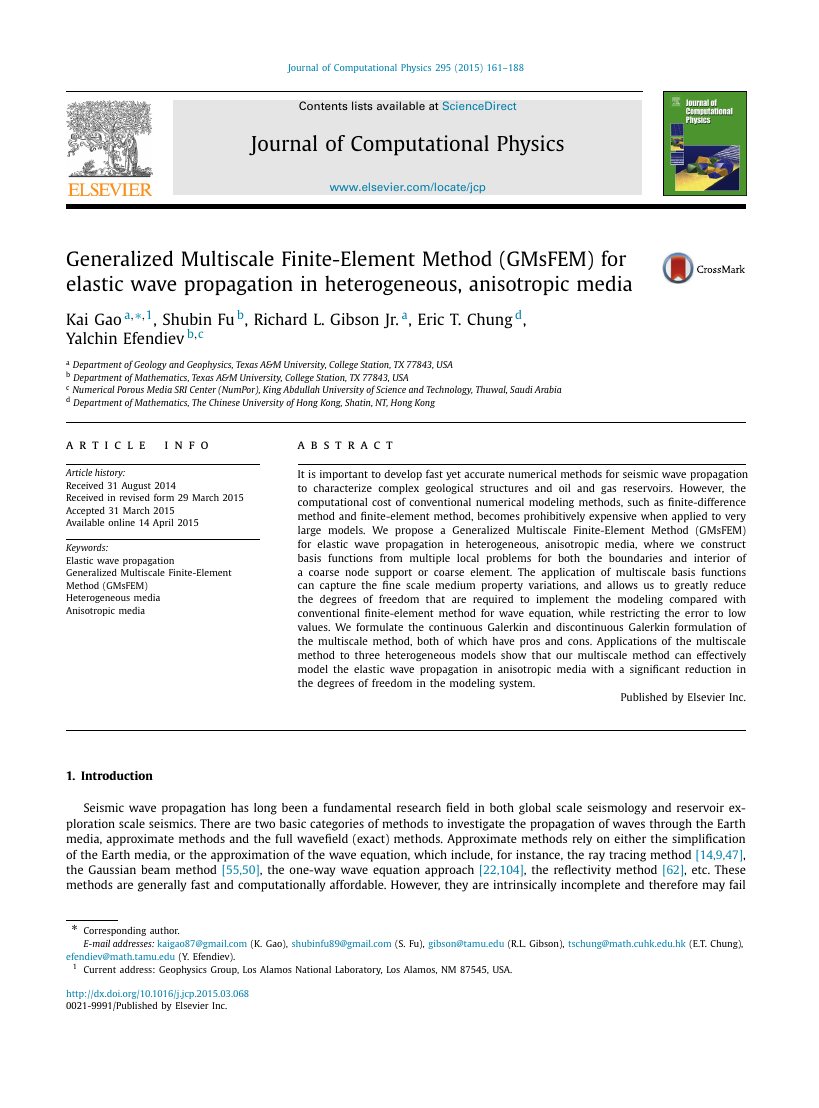
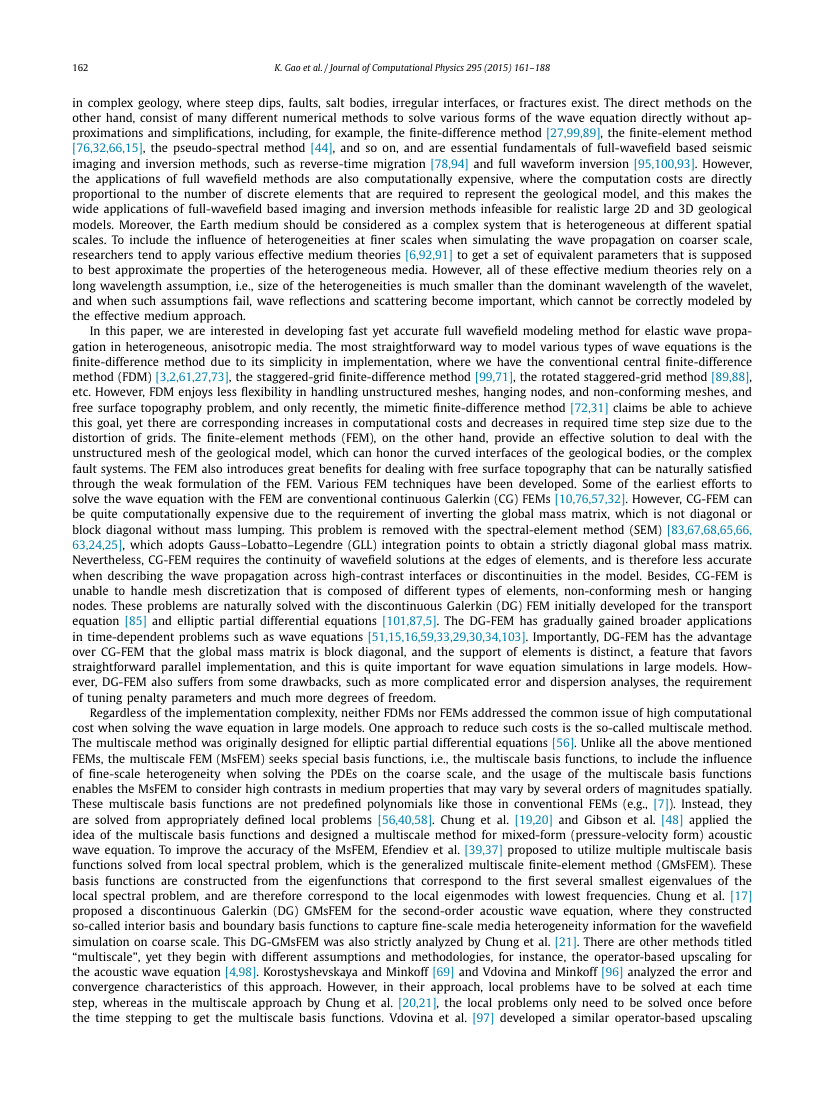
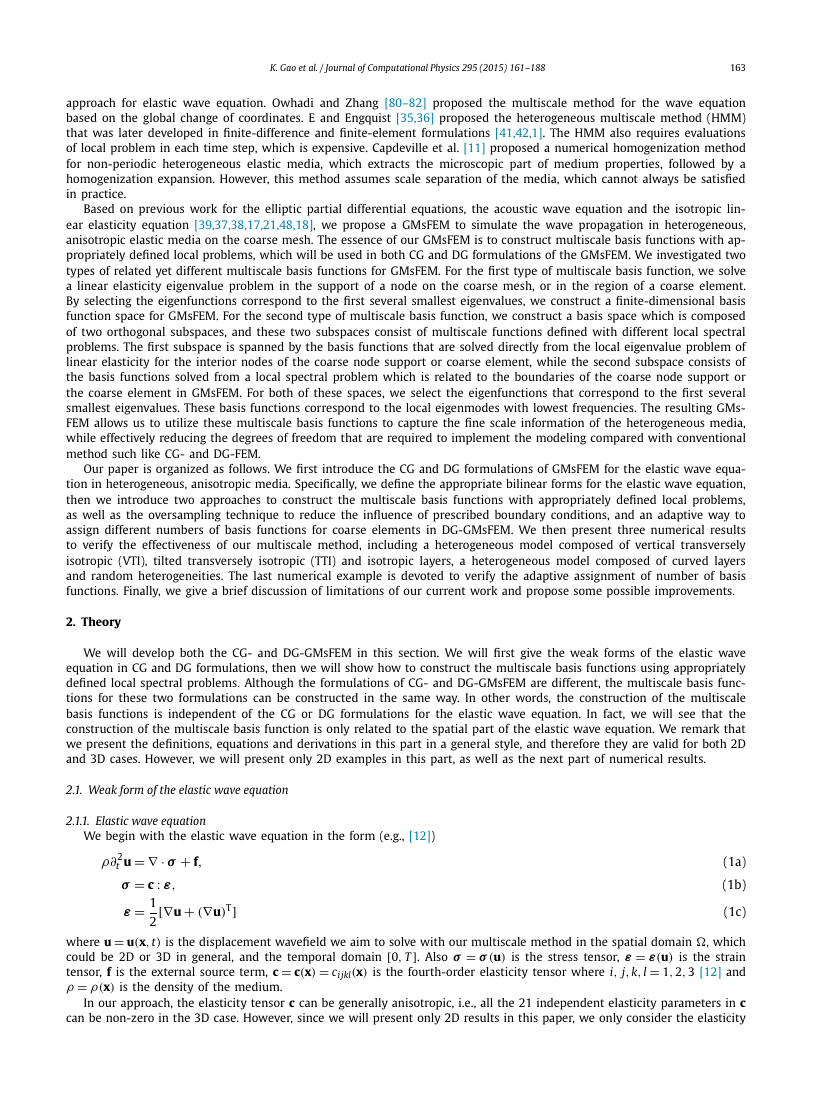
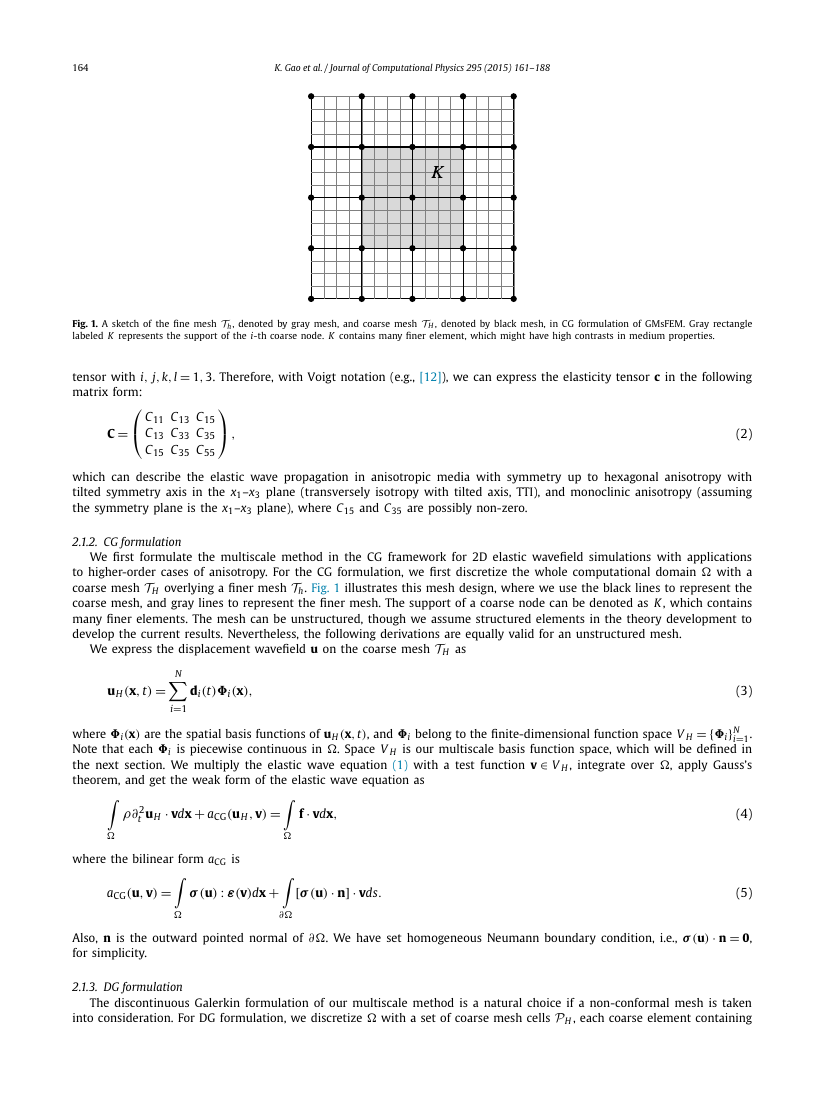
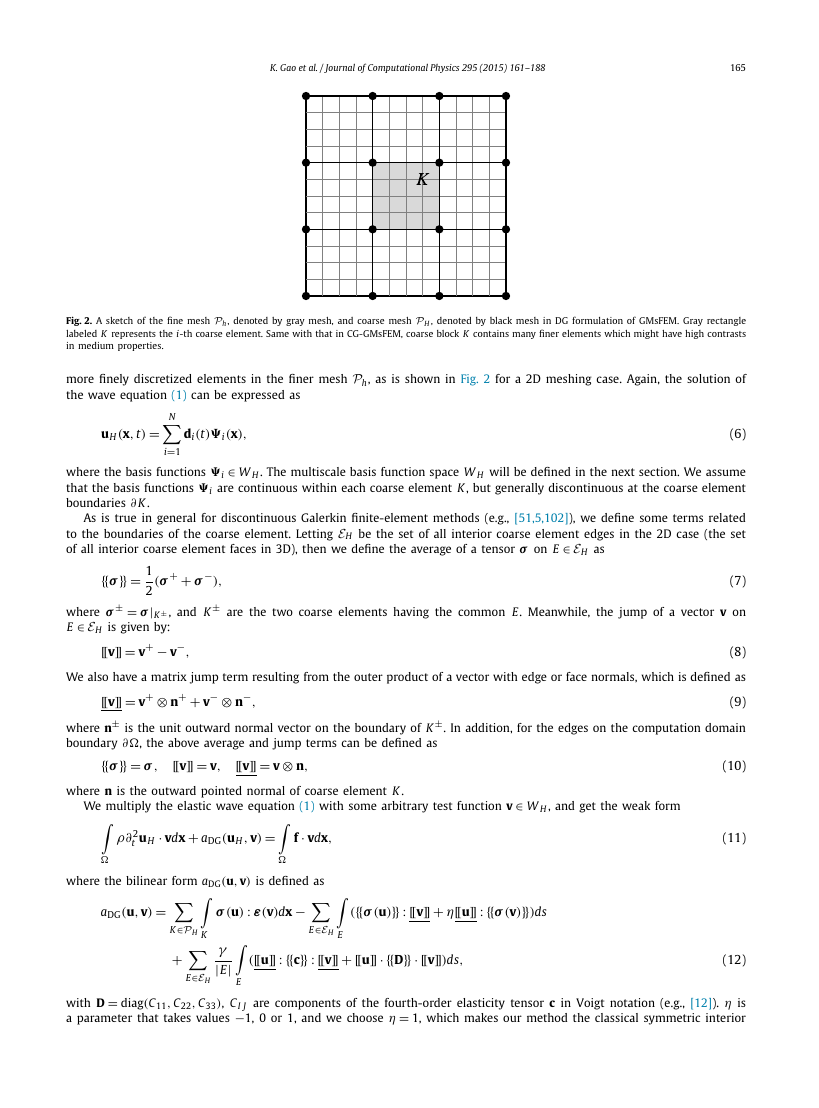
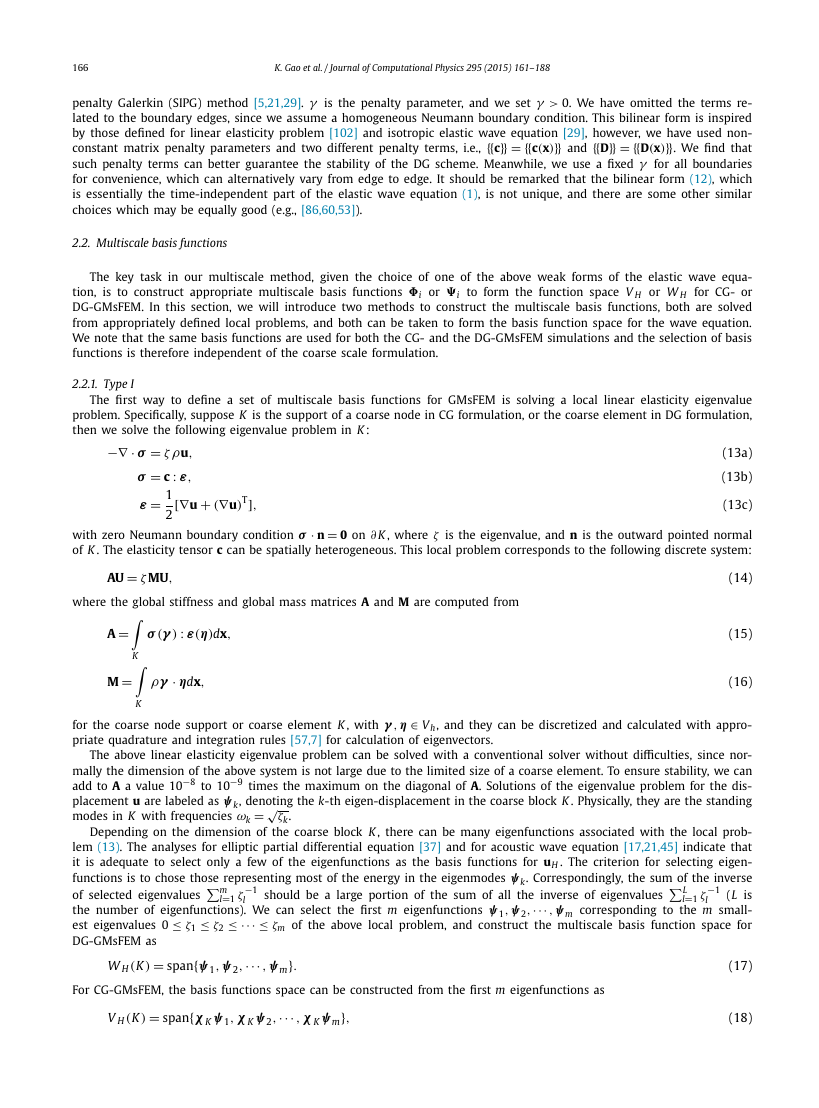
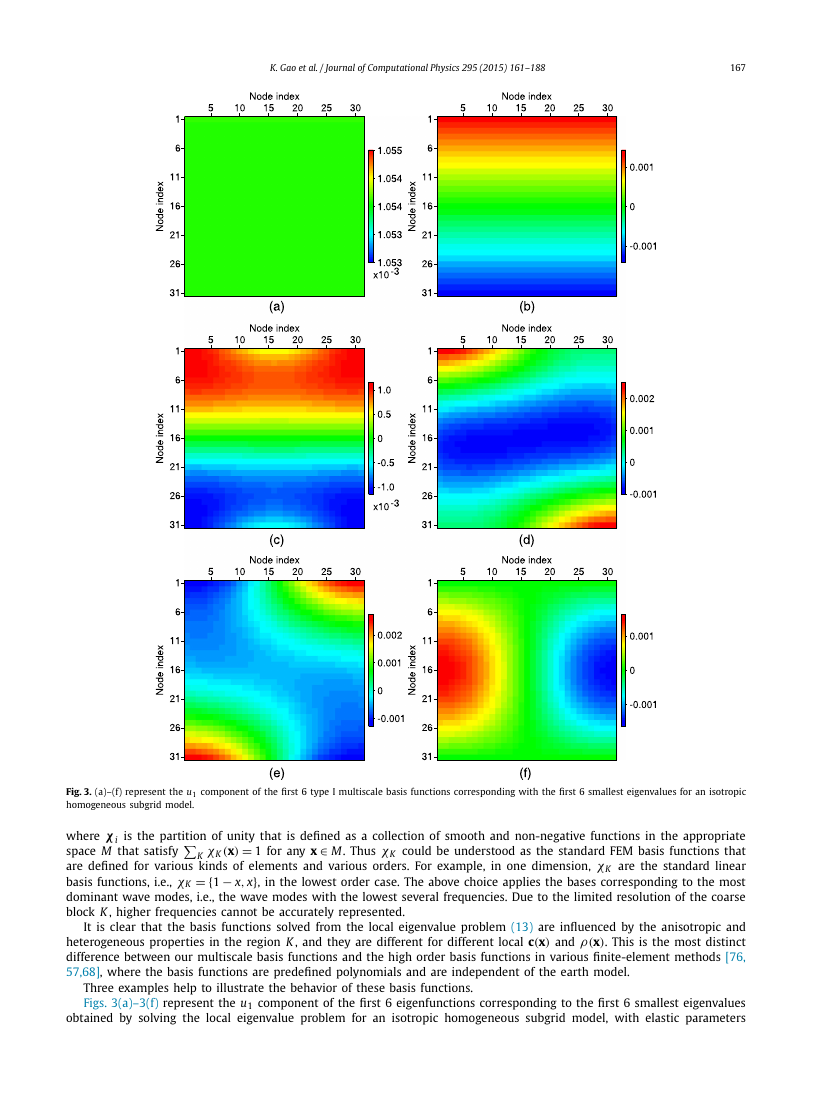
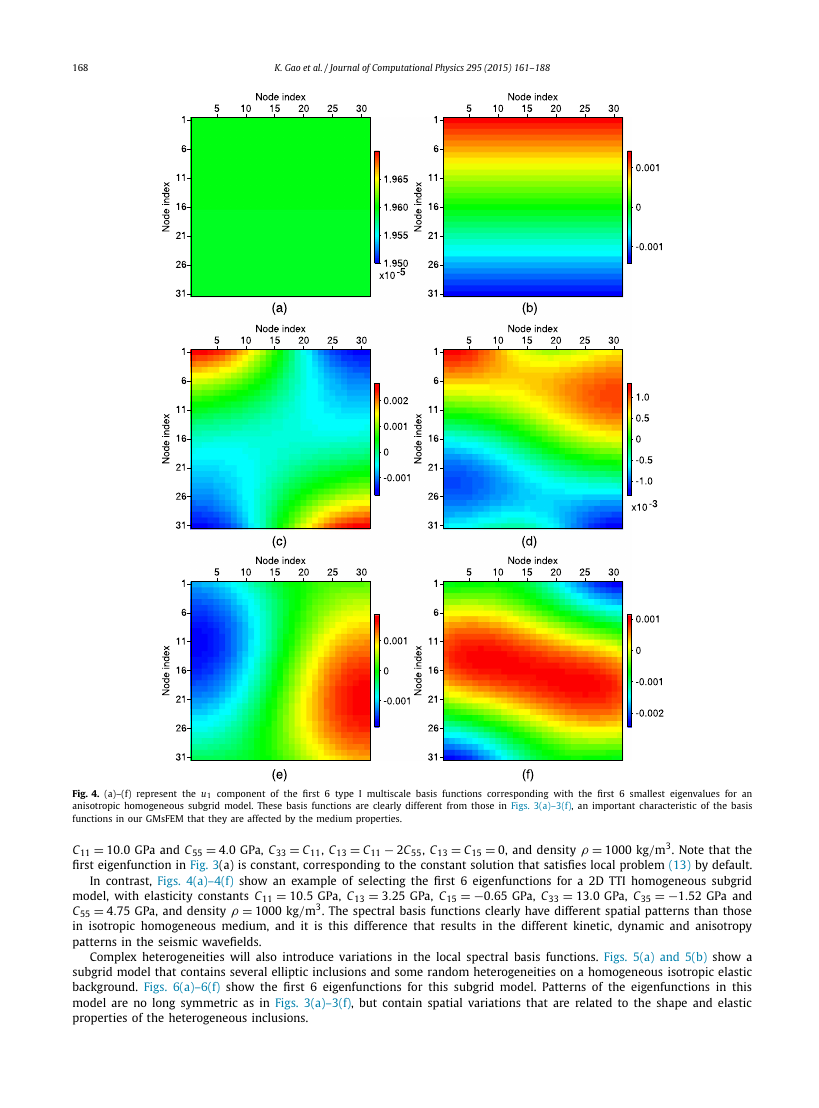








 2023年江西萍乡中考道德与法治真题及答案.doc
2023年江西萍乡中考道德与法治真题及答案.doc 2012年重庆南川中考生物真题及答案.doc
2012年重庆南川中考生物真题及答案.doc 2013年江西师范大学地理学综合及文艺理论基础考研真题.doc
2013年江西师范大学地理学综合及文艺理论基础考研真题.doc 2020年四川甘孜小升初语文真题及答案I卷.doc
2020年四川甘孜小升初语文真题及答案I卷.doc 2020年注册岩土工程师专业基础考试真题及答案.doc
2020年注册岩土工程师专业基础考试真题及答案.doc 2023-2024学年福建省厦门市九年级上学期数学月考试题及答案.doc
2023-2024学年福建省厦门市九年级上学期数学月考试题及答案.doc 2021-2022学年辽宁省沈阳市大东区九年级上学期语文期末试题及答案.doc
2021-2022学年辽宁省沈阳市大东区九年级上学期语文期末试题及答案.doc 2022-2023学年北京东城区初三第一学期物理期末试卷及答案.doc
2022-2023学年北京东城区初三第一学期物理期末试卷及答案.doc 2018上半年江西教师资格初中地理学科知识与教学能力真题及答案.doc
2018上半年江西教师资格初中地理学科知识与教学能力真题及答案.doc 2012年河北国家公务员申论考试真题及答案-省级.doc
2012年河北国家公务员申论考试真题及答案-省级.doc 2020-2021学年江苏省扬州市江都区邵樊片九年级上学期数学第一次质量检测试题及答案.doc
2020-2021学年江苏省扬州市江都区邵樊片九年级上学期数学第一次质量检测试题及答案.doc 2022下半年黑龙江教师资格证中学综合素质真题及答案.doc
2022下半年黑龙江教师资格证中学综合素质真题及答案.doc